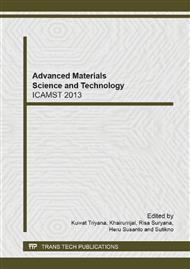p.237
p.241
p.245
p.249
p.253
p.259
p.263
p.267
p.272
Effect of Anodizing in Surface Finishing on Speed Boat Impeller Made of Aluminum
Abstract:
Aluminum alloy have been used for machine components in many functions and sizes. Every part need to be strong and long life, but when wear should be considered, then one have to hardened the surface, usually the harder the surface, the longer the life. One of the components that mention above is speed boat impeller. The sea water may cause the surface of the impeller eroded. Base on that reason the impeller should be hardened to extend its life. The anodizing process was chosen to improve the surface quality of the aluminum to reduce abrasion/erosion. Aluminum is a special material, other metal will be damaged or being worse when corroded, but Aluminum oxide is harder then the pure aluminum. In this process we use H2SO4 solution and the range of the anodizing temperature were changed gradually. This process was using single electrical force 20 Volt, to serve the anodizing for several minutes. All specimens finally were tested in Vickers micro hardness tester, also in Ogoshi High Speed Universal Wear Testing Machine. The last but not least, we cuts the specimens to see the thickness of the oxide layer by SEM. The result shows that for both hardness and wear, the quality of the surface increase with the increase of the solution of H2SO4, and also better for longer anodizing time. The thickness of the oxide layer was measured using SEM, at five places, and the average of the thickness is 2.662 mm.
Info:
Periodical:
Pages:
253-256
Citation:
Online since:
February 2014
Authors:
Keywords:
Price:
Сopyright:
© 2014 Trans Tech Publications Ltd. All Rights Reserved
Share:
Citation:


